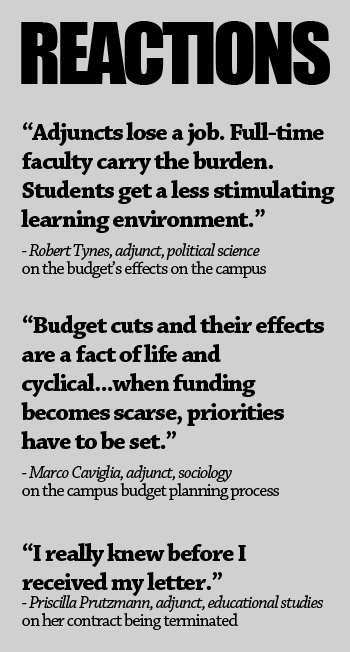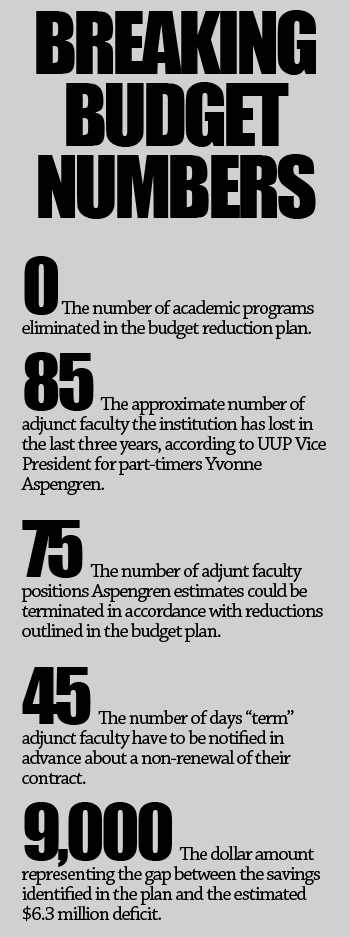

After eight months of speculation, Interim President Donald Christian announced budget plans for meeting the college’s estimated $6.3 million deficit that did not include the elimination of any academic programs. But John Menegon, an adjunct of the Music department, said his colleagues and students need to do one thing when considering how portions of the plan like the $903,000 cut in the part-time personnel budget will affect the quality of education on campus.
“Pray for a miracle,” he said.
The budget reduction plan for the 2011-2012 year at SUNY New Paltz was shared with the faculty, staff and students in a series of e-mails Monday. The plan now outlined on budget.newpaltz.edu highlights reductions ranging from a decrease in utility expenses, consolidation and reorganization of services and a reduction of the part-time faculty budget that have left adjuncts questioning their future with the institution.
 Since last fall, Christian has worked with his cabinet, deans, administrators and other advisers to formulate ideas for economizing in light of a deficit. He said the budget gap was caused by decreases in state taxpayer support and contractual salary increases, among other factors.
Since last fall, Christian has worked with his cabinet, deans, administrators and other advisers to formulate ideas for economizing in light of a deficit. He said the budget gap was caused by decreases in state taxpayer support and contractual salary increases, among other factors.
When Gov. Andrew Cuomo’s Executive Budget proposal was passed by the New York State Legislature several weeks ago, administrators told the campus that the estimated $3.25 million budget shortfall could widen to $6.3 million because of a 10 percent cut in SUNY funding.
The cuts outlined in the campus reduction plan include, but are not limited to, the following:
- an $800,000 reduction in utilities expenditures
- a $1.794 million reduction through consolidation and reorganization of services
- a net of $220,000 in salary savings, representing the difference between the salary total of retiring faculty and that anticipated for new hires
- a $223,000 reduction in Other Than Personnel (OTPS) services
- a $788,000 savings through “academic realignment and reconfiguration”
- a $903,000 cut in the part-time personnel budget
Christian said these adjustments in spending were planned to sustain access and a high quality of education for the students of the college.
“It’s all following the criteria and process that we’ve used and laid out early in the year, putting a priority on protecting educational opportunities for students, safeguarding the positions of permanent employees, paying careful attention to quality and reinforcing that there is no easy way to do this,” he said.
After hearing the “concerns of the community” regarding the possible elimination of academic programs in the fact of the deficit, Christian said he and his colleagues were relieved that they were able to find alternatives to prevent this from happening. But some members of the adjunct faculty said they were forced to carry a heavier financial burden for administrators to realize these goals.
Yvonne Aspengren, an adjunct professor of German and the United University Professions (UUP) union’s vice president for part-timers, said substantial damage has come down on the cuts to the adjunct budget since administrators were committed to full-timers and keeping all academic programs.
“It’s a big hit,” she said. “It is disturbing for adjuncts who have been here a long time and done a good job of teaching and became part of the institution. They’re not in that pool of who they’re watching out for.”
a good job of teaching and became part of the institution. They’re not in that pool of who they’re watching out for.”
The reduction plan calls for a 29 percent cut to the part-time personnel budget, which Aspengren said could translate to an estimated 75 adjuncts losing work. Christian said he could not comment on the exact number of part-timers that would be released at this time.
Some members of the adjunct faculty said they have already been notified that their contract would not be renewed next year.
Lyla Yastion, a part-timer who taught two electives in the Anthropology department for three years, said her temporary contract has been terminated. Questioning if the criteria used by administrators to make the severe budget cuts were “right and just,” she said she is disappointed about losing the chance to teach courses that she felt were unique and helped diversify learning opportunities offered at SUNY New Paltz.
“Students are being denied the wide variety of courses which a top level university like SUNY should provide. A diverse spectrum of courses and teachers who excel at teaching are factors that should carry weight in decisions that affect the quality of education,” she said. “After all, it is the quality of education that is the primary goal of any university worth its salt.”
Aspengren agreed that the loss of these members of the faculty that will result from the budget plan would impact students’ education at the college, saying that adjuncts maintain their positions because they love what they are teaching and want to work with students. She said that students could miss out on practical experience that adjuncts can provide in their teaching methods as she continues to hear from more of her colleagues whose contracts are not being renewed.
It is a requirement for “term” adjuncts, or those who have taught at the college for six consecutive semesters, to be notified 45 days before their contract expires if they are not being renewed. Aspengren said newer part-timers receive shorter notice. Because adjunct positions are contingent upon enrollment and program needs, she also said those who have not received letters of non-renewal aren’t guaranteed to be teaching in the fall.
Susan Miiller, an adjunct in the art education department, said she has not received a contract for the fall or spring 2012, and that if she doesn’t get one by early May she would deem herself to not be renewed.
While already seeking other teaching options and considering early retirement, Miiller said this “aggressive” could could limit students’ options.
“Students will see an increase in class size and fewer sections of classes offered,” she said. “Full time faculty will be overwhelmed with little to offer students outside of scheduled class time.”
Christian said that modest increases in class sizes could result from a shift in workload to full-time faculty. According to the proposal, administrators will develop standards for teaching loads of faculty over the next several months based on analysis of data for the past two years. He said they will rely on information Records and Registration and advising personnel while examining workloads. Faculty will be able to attend a forum about this research at the end of the spring semester.
Other academic implications of the reduction plan include possible increases in student course fees and reconfigured staffing in the Mathematics and Computer Science departments. Special fees generated in the Educational
The proposed actions in the planned totaled a $6.291 million reduction, leaving administrators $9,000 shy of achieving a $6.3 million economization. Christian said this balance may be covered on a temporary basis through use of reserve funds.
“Students are being denied the wide variety of courses which a top level university like SUNY should provide. A diverse spectrum of courses and teachers who excel at teaching are factors that should carry weight in decisions that affect the quality of education,” she said. “After all, it is the quality of education that is the primary goal of any university worth its salt.”
Aspengren agreed that the loss of these members of the faculty that will result from the budget plan would impact students’ education at the college, saying that adjuncts maintain their positions because they love what they are teaching and want to work with students. She said that students could miss out on practical experience that adjuncts can provide in their teaching methods as she continues to hear from more of her colleagues whose contracts are not being renewed.
It is a requirement for “term” adjuncts, or those who have taught at the college for six consecutive semesters, to be notified 45 days before their contract expires if they are not being renewed. Aspengren said newer part-timers receive shorter notice. Because adjunct positions are contingent upon enrollment and program needs, she also said those who have not received letters of non-renewal aren’t guaranteed to be teaching in the fall.
Susan Miiller, an adjunct in the art education department, said she has not received a contract for the fall or spring 2012, and that if she doesn’t get one by early May she would deem herself to not be renewed.
While already seeking other teaching options and considering early retirement, Miiller said this “aggressive” approach could limit students’ options.
“Students will see an increase in class size and fewer sections of classes offered,” she said. “Full time faculty will be overwhelmed with little to offer students outside of scheduled class time.”
Christian said that modest increases in class sizes could result from a shift in workload to full-time faculty. According to the proposal, administrators will develop standards for teaching loads of faculty over the next several months based on analysis of data for the past two years. He said they will rely on information from Records and Registration and advising personnel while examining workloads. Faculty will be able to attend a forum about this research at the end of the spring semester.
Other academic implications of the reduction plan include possible increases in student course fees and reconfigured staffing in the Mathematics and Computer Science departments.
The proposed actions in the plan totaled a $6.291 million reduction, leaving administrators $9,000 shy of achieving a $6.3 million economization. Christian said this balance may be covered on a temporary basis through use of reserve funds.
